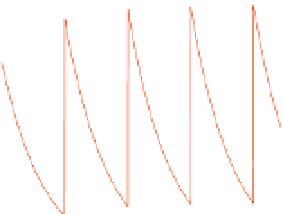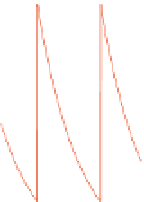Biomedical Engineering Reference
In-Depth Information
Þ
e
2
c
1
¼
q
1
ð
0
V
1
¼
e
2
,and
In the first interval,
c
1
min
equals 30 percent of the initial value, or
c
1
min
¼
0
:
3
:
At steady state, the minimum concentration is determined from Eq. (7.46) as
e
2
z
e
K
10
T
V
1
1
c
1
min
¼
0
:
3
¼
Þ
¼
ð
e
K
10
T
e
2
1
Solving the previous equation for
T,
we have
T
'
3 hours
:
Thus, the antibiotic needs to be
administered every 3 hours, as shown in Figure 7.14.
1.5
1.3
1.1
0.9
0.7
0.5
0.3
0.1
0
5
10
15
20
-0.1
Time, hours
FIGURE 7.14
Change in concentration with a repeat dose of the antibiotic every 3 hours.
7.6 TWO-COMPARTMENT MODELING
The general form of the two-compartment model is shown in Figure 7.15. Here we
assume that all transfer rates are constants and
0.
We begin with the general form of the two-compartment model and then examine special
cases with some of the transfer rates or inputs set equal to zero and other considerations. To
analyze the system in Figure 7.15, conservation of mass is used to write a differential equation
for each compartment describing the rate of change of the quantity of solute in the compart-
ment, given as accumulation
K
ij
¼
input - output, where
Compartment 1
Accumulation
Compartment 2
Accumulation
¼
q
1
¼
q
2
Input
¼
f
1
ð
t
Þþ
K
21
q
2
Ouput
Input
¼
f
2
ð
t
Þþ
K
12
q
1
Ouput
¼ð
K
10
þ
K
12
Þ
q
1
¼ð
K
20
þ
K
21
Þ
q
2
Therefore,
q
1
¼
f
1
ð
t
Þþ
K
21
q
2
ð
K
10
þ
K
12
Þ
q
1
q
2
¼
f
2
ð
t
Þþ
K
12
q
1
ð
K
20
þ
K
21
Þ
q
2
ð
7
:
47
Þ




























